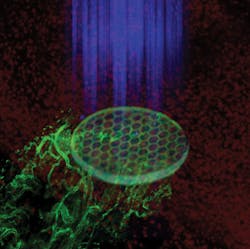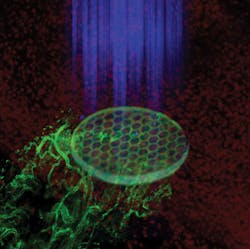PHOTODYNAMIC THERAPY: Molecular disguises allow in vivo light activation of signaling peptides
Scientists have demonstrated the use of disguises to sneak biomaterials containing peptide-signaling molecules into the bodies of living animals.1 Ultraviolet light shone on the skin then triggers the peptides to shed their disguises and set off processes. The work represents the first time biological signals presented on biomaterials have been activated by light through the skin of a living animal.
The technique could someday work in humans to enable more precise timing for processes essential to regenerative medicine, cancer treatment, immunology, and stem cell growth, among other applications.
When biomaterials are introduced into the body, they normally stimulate an immune system response immediately. But the researchers used molecular cages to cover binding sites on the peptides that are normally recognized by cell receptors, preventing recognition by the animal's cells. The cages were designed to detach and reveal the peptides when they encounter specific wavelengths of light. The work represents collaboration between scientists from Georgia Tech and the Max-Planck Institute in Germany through the Materials World Network Program. During the five-year project, the research team showed that disguised peptides could trigger cell adhesion, inflammation, fibrous encapsulation, and vascularization responses when activated by light. They also showed that the location and timing of activation could be controlled inside the animal by simply shining light through the skin.
The work involved numerous controls to ensure that the triggering observed was actually done by exposure of the peptides—not the light, or the removal of the protective cage. The researchers also had to demonstrate that the cages were stable enough to remain in place until the link with the peptide was severed by the ultraviolet light.
In the future, photochemists at Max-Planck will be working on alternative cages that could allow sequential activation by light, and activation using longer light wavelengths of molecules deeper inside the body.
Light, heat, and electricity have been used to trigger biological processes in vitro, but light is especially useful because it can be patterned to control processes spatially, which is also important because the processes must occur not only at the right time, but also the right place. "The technique we developed is a general strategy that we can apply to other biological signals to see if they have similar spatio-temporal effects," said Andrés García of Georgia Tech, principal investigator for the project. "We see this as a beginning. From here, there are many, many applications that we can follow."
1. T. Lee et al., Nat. Mater., doi:10.1038/nmat4157 (2014).

